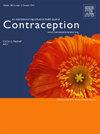建立以证据为基础的避免怀孕措施的切入点
IF 2.3
2区 医学
Q1 OBSTETRICS & GYNECOLOGY
引用次数: 0
摘要
目的学者们表达了对“意外怀孕”的替代措施的迫切需要,以捕捉人们是否达到了他们的生育偏好。利用避免怀孕愿望(DAP)量表的优势,我们建立了基于证据的切入点,定义了孕前偏好的标准化分组,以扩大量表的效用。方法来自美国9个州的45000多名年龄在18-44岁的女性完成了基于人口的女性调查(2017-2023)的DAP量表。我们将数据拟合到项目反应模型中,并生成了一个构造图,这是受访者在每个DAP项目的0-4范围内认可每个反应类别的概率的可视化表示。此外,我们用混合效应模型预测了DAP水平下避孕药具使用和意外怀孕的概率。在2024-2025年,我们两次召集了一个由不同的计划生育专家组成的小组,他们根据这些材料确定了具有经验意义的DAP分组和标签。结果对DAP的三种分组均有专家共识。DAP得分高的个体(>2.5-4)的反应显示出强烈的避免怀孕倾向。那些得分中等(>1.5-≤2.5)的人的项目回答表明他们对避免怀孕有中等偏好(即不确定或矛盾)。DAP得分低的个体(0-1.5)对怀孕持开放态度(即渴望或愿意接受怀孕)。大约50%、30%和20%的女性分别有高、中、低DAP得分。结论sdap分组为研究人员提供了一种必要的分类编码选择,有助于将严格的、以人为本的措施整合到未来的研究和监测中。生殖健康研究中的其他关键措施也可采用类似的方法。本文章由计算机程序翻译,如有差异,请以英文原文为准。
ESTABLISHING EVIDENCE-BASED CUT-POINTS ON THE DESIRE TO AVOID PREGNANCY MEASURE
Objectives
Scholars express an urgent need for alternative measures to “unintended pregnancy” that capture whether people attain their reproductive preferences. Capitalizing on the strengths of the Desire to Avoid Pregnancy (DAP) scale, we established evidence-based cut-points, defining standardized groupings of pre-pregnancy preferences to expand the scale’s utility.
Methods
More than 45,000 females, aged 18-44, across nine US states completed the DAP scale in the population-based Surveys of Women (2017-2023). We fit data to an item response model and generated a construct map, a visual representation of respondents’ probabilities of endorsing each response category over the 0-4 range of each DAP item. Additionally, we generated predicted probabilities of contraceptive use and incident pregnancy across DAP levels with mixed effects models. In 2024-2025, we twice convened a panel of diverse family planning experts, who identified empirically meaningful DAP groupings and labels based on these materials.
Results
Expert consensus was reached on three DAP groupings. Individuals with High DAP scores (>2.5-4) have responses demonstrating a strong preference to avoid pregnancy. Those with Mid-range scores (>1.5-≤2.5) have item responses indicating a moderate preference to avoid pregnancy (ie, uncertain or ambivalent). Individuals with Low DAP scores (0-1.5) are open to pregnancy (ie, desire or would be receptive to pregnancy). Approximately 50%, 30%, and 20% of females had High, Mid-range, and Low DAP scores, respectively.
Conclusions
DAP groupings offer researchers a necessary categorical coding option, facilitating the integration of rigorous, person-centered measures into future research and surveillance. A similar methodology could be employed for other critical measures in reproductive health research.
求助全文
通过发布文献求助,成功后即可免费获取论文全文。
去求助
来源期刊

Contraception
医学-妇产科学
CiteScore
4.70
自引率
17.20%
发文量
211
审稿时长
69 days
期刊介绍:
Contraception has an open access mirror journal Contraception: X, sharing the same aims and scope, editorial team, submission system and rigorous peer review.
The journal Contraception wishes to advance reproductive health through the rapid publication of the best and most interesting new scholarship regarding contraception and related fields such as abortion. The journal welcomes manuscripts from investigators working in the laboratory, clinical and social sciences, as well as public health and health professions education.
 求助内容:
求助内容: 应助结果提醒方式:
应助结果提醒方式:


